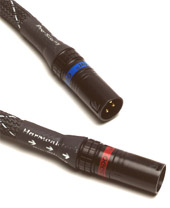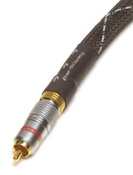Harmonic Tech Versus the Tweakerholic?
| Harmonic Tech Versus the Tweakerholic? |
| Marhsall Nack |
| 10 June 1999 |

 Specifications
Specifications
Pro-Silway 7N single-crystal silver 1 meter RCA terminated interconnect cables, $399.00/pr.
7N single-crystal silver 1 meter XLR balanced interconnect cables, $439.00/pr.
Additional per 1 meter per pair Pro-Silway interconnect cables, $240/pr.
Harmonic Technology:
12781 Legacy Place
San Diego, CA 92131
Tel: 619/578-7788
Fax: 619/586-7918
E-mail: harmonic@san.rr.com
Website: http://www.harmonictech.com
Harmonic Technology Pro-Silway MKII Interconnects
Reference system: my LP12 with AQ 7000 cartridge is connected to a Graham IC30 cable, which in turn is plugged into a BYBEE interconnect filter. The BYBEE’s output goes to Dan Fanny’s AHT Non-Signature phono stage. The output from the phono stage is sent to a McCormack TLC-1 passive line stage via ½ meter of Harmonic Technology (HT) Truth-Link copper wire. The passive line stage feeds another ½ meter of HT Truth-Link, into another set of BYBEEs and is then run to my BAT VK-200 stereo amp. Magnepan MG 3.3 speakers are connected via a 6′ HT Pro-11 Plus.
The Harmonic Technology Truth-Link interconnect became my reference because it offered pretty near everything an audiophile dreams of, and then added many of the characteristics a music lover dreams of. It gives you imaging and a 3-D soundstage, good bass and extended treble. Then it adds signal purity and harmonic integrity. It seemed to me as good as my prior reference, the NBS King Serpent II, at about 1/5 the cost. Out went the NBS. Then 2 weeks ago in went the Pro-Silway.
Listening Impressions
You can tell the presentation is improved in a big way, but it is difficult to get a handle on precisely what is different. The Pro-Silway had the same natural timbre and good tonal balance across the audio band as with Truth-Link. As time passed, I noted more clarity and detail without loss of body. Increased spaciousness and naturalness were apparent. The major changes over the Truth-Link can be described as a more crisp, clear and solid sounding presentation. Instruments had more weight.
In the middle of all this, I took a break to make a foray to my favorite classical vinyl haunt, Academy Records on West 18th Street, in NYC. I picked up what have become two additions to my desert island pile. One is the well known Mahler Symphony No. 3, with Mehta and the LA Philharmonic (London CSA2249). If your system can accommodate full orchestra, this disc will overwhelm you. Time and again I put it on to check out a system change and find I am unable to lift the needle until at least Side 1 is finished. Lest I forget to mention the performance is first rate with Mehta in full creative control. After a steady diet of baroque and classical, Mahler’s music comes as a shock. One hundred years later, the sensibility seems contemporary, it being sarcastic, mocking, and macabre. The performance seems almost too perfect and pure sounding. And maybe it is.
The stage is very deep with silent space between the extremely well reproduced instruments. With the Pro-Silway in the system it was easy to discern the recording engineer’s miking technique. For example, towards the end of Side 1 there is a little drum solo that sounds like it’s in another room. It was obviously recorded with a spot mike.
The other disc is a sleeper: Actéon by Marc-Antoine Charpentier performed by Les Arts Florissants led by William Christie (Harmonia Mundi HM1095). Amazingly well recorded in 1982, it presents a lush, warm and intimate acoustic that will take over your room with an enormous natural soundstage. The hall is present, lending ambience so that the space between performers feels occupied. This kind of ambience feels more natural sounding than the cool silence of the Mahler third symphony. This work is an early French opera, written around the time Henry Purcell was composing in England. I find it almost as enjoyable as Purcell’s Dido and Aeneas. By the way, my favorite D&A is the one with Janet Baker led by Anthony Lewis (L’Oiseau Lyre SOL60047), recorded in 1962.
Whether owing to this group’s original instrument practice or respect for the age of the score, the Charpentier does not exhibit full blown operatic mannerisms; hence I can enjoy it. The singing is a cross between opera and recitative. Unlike say, Jean Phillipe Rameau compositions of fifty years later, it doesn’t have that over-controlled dramatic exhibition of vocal technique that I find off-putting in full blown opera.
After another 24 hours break-in one begins to notice disconcerting nuances, like how the harpsichord is far right for chorus passages, but moves to left of center on solo voice sections. The aural lens is sharpening to greater focus.
Another by-the-way, regarding turntable setup–long ago I removed the base of my LP12. The table sits on a bunch of hardened carbon blocks made by Air Tight. The blocks in turn sit on a sandbox, by Bright Star. The sandbox sits on a Townshend Seismic Sink. All of this occupies the top shelf of my Solid Steel model 410.
Anyway, I acquired more carbon blocks and put an additional one under each side of the table. So now there are eight blocks under the table. Surprisingly, even with all those levels of isolation, the presentation improved. As the table was mechanically supported by more blocks, the soundstage crystallized. Center came into focus. Vagueness and smearing were reduced. The result was an increased impression of solidity with rock-solid images in space.
Truth Be Told
Finally it was time to put the Truth-Link back in place between the phono preamp and the line stage. The Truth-Link still sounded good, but was noticeably recessive. Imaging became blurred. No question, I wanted the Pro-Silway back.
My listening impression overall can be summed-up as follows: the sound had more vitality, it was more forward (than the Truth-Link); the stage got wider and the imaging was enhanced without loss of instrumental body. The Pro-Silway Mk II presents a substantial improvement over the Truth-Link, a cable I had previously considered to be a contender for the best available.
![]()
Don’t forget to bookmark us! (CTRL-SHFT-D)
Stereo Times Masthead
Publisher/Founder
Clement Perry
Editor
Dave Thomas
Senior Editors
Frank Alles, Mike Girardi, Russell Lichter, Terry London, Moreno Mitchell, Paul Szabady, Bill Wells, Mike Wright, and Stephen Yan,
Current Contributors
David Abramson, Tim Barrall, Dave Allison, Ron Cook, Lewis Dardick, John Hoffman, Dan Secula, Don Shaulis, Greg Simmons, Eric Teh, Greg Voth, Richard Willie, Ed Van Winkle, Rob Dockery, Richard Doron, and Daveed Turek
Site Management Clement Perry
Ad Designer: Martin Perry





Be the first to comment on: Harmonic Tech Versus the Tweakerholic?